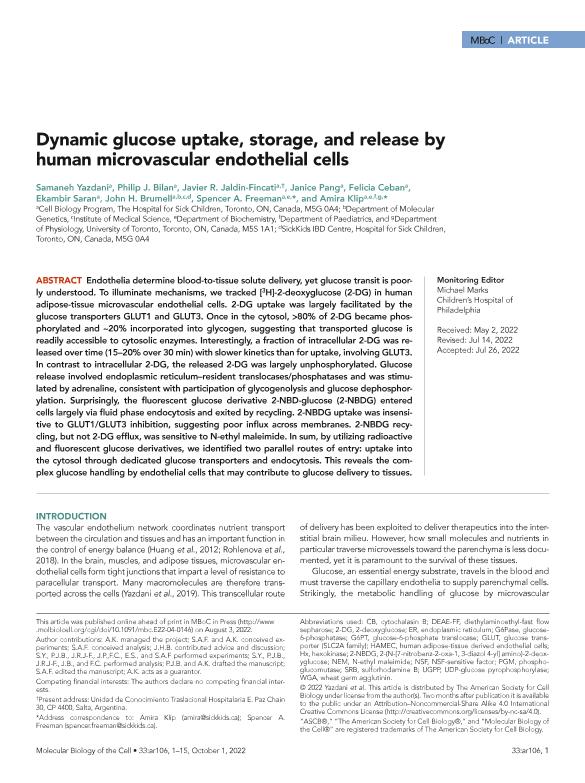Artículo
Dynamic glucose uptake, storage, and release by human microvascular endothelial cells
Yazdani, Samaneh; Bilan, Philip J.; Jaldín Fincati, Javier Roberto ; Pang, Janice; Ceban, Felicia; Saran, Ekambir; Brumell, John H.; Freeman, Spencer A.; Klip, Amira
; Pang, Janice; Ceban, Felicia; Saran, Ekambir; Brumell, John H.; Freeman, Spencer A.; Klip, Amira
 ; Pang, Janice; Ceban, Felicia; Saran, Ekambir; Brumell, John H.; Freeman, Spencer A.; Klip, Amira
; Pang, Janice; Ceban, Felicia; Saran, Ekambir; Brumell, John H.; Freeman, Spencer A.; Klip, Amira
Fecha de publicación:
07/2022
Editorial:
American Society for Cell Biology
Revista:
Molecular Biology Of The Cell
ISSN:
1059-1524
Idioma:
Inglés
Tipo de recurso:
Artículo publicado
Clasificación temática:
Resumen
Endothelia determine blood-to-tissue solute delivery, yet glucose transit is poorly understood. To illuminate mechanisms, we tracked [3H]-2-deoxyglucose (2-DG) in human adipose-tissue microvascular endothelial cells. 2-DG uptake was largely facilitated by the glucose transporters GLUT1 and GLUT3. Once in the cytosol, >80% of 2-DG became phosphorylated and ∼20% incorporated into glycogen, suggesting that transported glucose is readily accessible to cytosolic enzymes. Interestingly, a fraction of intracellular 2-DG was released over time (15–20% over 30 min) with slower kinetics than for uptake, involving GLUT3. In contrast to intracellular 2-DG, the released 2-DG was largely unphosphorylated. Glucose release involved endoplasmic reticulum–resident translocases/phosphatases and was stimulated by adrenaline, consistent with participation of glycogenolysis and glucose dephosphorylation. Surprisingly, the fluorescent glucose derivative 2-NBD-glucose (2-NBDG) entered cells largely via fluid phase endocytosis and exited by recycling. 2-NBDG uptake was insensitive to GLUT1/GLUT3 inhibition, suggesting poor influx across membranes. 2-NBDG recycling, but not 2-DG efflux, was sensitive to N-ethyl maleimide. In sum, by utilizing radioactive and fluorescent glucose derivatives, we identified two parallel routes of entry: uptake into the cytosol through dedicated glucose transporters and endocytosis. This reveals the complex glucose handling by endothelial cells that may contribute to glucose delivery to tissues.
Palabras clave:
Glucose
,
Microvascular endothelial cells
,
2-NBDG
,
GLUT1
,
GLUT3
Archivos asociados
Licencia
Identificadores
Colecciones
Articulos(IPE)
Articulos de INST.DE PATOLOGIA EXPERIMENTAL
Articulos de INST.DE PATOLOGIA EXPERIMENTAL
Citación
Yazdani, Samaneh; Bilan, Philip J.; Jaldín Fincati, Javier Roberto; Pang, Janice; Ceban, Felicia; et al.; Dynamic glucose uptake, storage, and release by human microvascular endothelial cells; American Society for Cell Biology; Molecular Biology Of The Cell; 33; 12; 7-2022; 1-15
Compartir
Altmétricas



